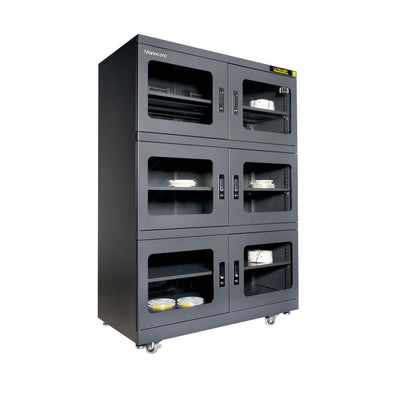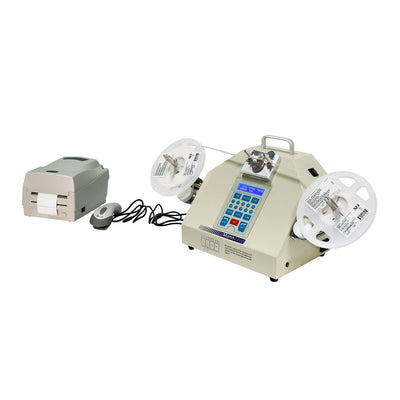
Independent Upper and Lower PID Temperature Controls
When you choose the CR5000 for your facility, you'll get the benefits of an oven that operates with a flawless heating accuracy of ±1°C and an ensured ΔT of ±2°C. Our diffuser design also provides you with low-velocity, low-turbulence airflow to prevent any component-shifting or other disturbances. Experience excellent reflow soldering results at a better throughput than many ovens of this size can match.
Accurate, real-time temperature profiling to meet the specifications of any solder paste manufacturer is available. This software pairs with the included thermocouples, which can be attached at critical locations on the PCB and be connected to the 3 standard CR-series thermocouple inputs.

Advanced Conveyor Systems
The combination of a 22.4" (570 mm) stainless-steel mesh belt and an adjustable-rail, pin-type conveyor system allows your CR5000 advanced conveyor to meet any production requirements. All of your components are constructed of top-strength stainless steel and are made to maintain dimensional tolerances at the high temperatures required for lead-free processing.
Inline operation, double-sided boards, advanced automatic chain lubrication, motorized width adjustment, and programmable conveyor speed (16"-71" or 400-1800 mm per minute) come standard on the pin conveyor. The automatic width adjustment (based on specific reflow program parameter settings) is an available option.

Easy-to-Use Control Software
Your CR5000 can be controlled with the full-screen graphical user interface. It has a virtual view of preset- and actual-zone temperatures, system statuses, and conveyor speeds. This display enables ease of use without reducing total process management; this unit's Windows-based control software allows for unlimited storage and networking capability along with advanced temperature profiling, timed automatic startup and shutdown, audio and visual alarms, and password protection functionality. Each unit features a 15" flat screen monitor, keyboard, and trackball along with a UPS battery backup to ensure safe removal of product from the oven in the case of a power outage.
| CR5000 Specifications | |
|---|---|
| # of Zones | 5 Upper, 5 Lower |
| Heating Mode | Hot Air Forced Convection |
| Heated Tunnel Length | 75" (1910 mm) |
| Temp Control | PID (Proportional-Integral-Differential) & SSR |
| Temperature Range | Ambient - 300°C |
| Precision of Temp Control | ±1° C |
| Delta T | ±2° C |
| Cooling Zones | 1 |
| Cooling Method | Wind Cooling System |
| On-Board Profiling with 3 Thermocouple Inputs | Yes |
| Ramp Up Time | ~35 min |
| Flux Management System | Yes |
| Mesh Belt Width | 22.4" (570 mm) |
| Pin Conveyor Width | 1.97"-17.7" (50-450 mm) |
| Max Component Height Upper | 30 mm (Above Pins) |
| Max Component Height Lower | 25 mm |
| Conveyor Speed | 0.4-1.8M/min |
| Conveyor Direction | Left-Right |
| Conveyor Height | 900 mm ±20 mm |
| Operating System | Windows 10 |
| Automatic Chain Lubrication | Yes |
| Power Requirement | 220 V 3-Phase, 125A, 60Hz |
| Power Consumption | 6.5-10 Kw |
| Total Power | 38 Kw |
| Compressed Air Supply | 80 psi |
| # of Exhaust Ports | 2 |
| Exhaust Opening Size | 8" |
| Total Exhaust Venting | 800CFM (400CFM Per Port) |
| Hood Opening Mechanism | Electric Raise and Lower |
| Net Weight | 2640 lbs (1200 kg) |
| Machine Dimension | 120" L x 55" W x 57" H (3040 x 1380 x 1445 mm) |
| UPS for Conveyor and PC | Yes |
| Shipping Dimension | 132" L x 65" W x 74" H (3330 x 1660 x 1880 mm) |
| Shipping Weight | 3366 lbs (1530 kg) |
| CE Compliance | Yes |
| Options | |
| Nitrogen Atmosphere Compatible | Yes |
| Infra-red (IR) | Yes |
| Central Support | Yes |
| SMEMA Compatible | Yes |
| Wider Pin and Mesh Conveyor | 17.7" (450 mm) |
| Internal Chilled Water Cooling | No |
| Exterior Chiller | No |
How 'Auto Focus Power' Profile Prediction Works:

1. Select Your Solder Paste Formula and Process Window
The KIC Auto-Focus Power software includes a database of over 1000 different solder paste formulas from dozens of different solder paste manufacturers. Each database entry includes the manufacturer's recommended solder profile for that specific solder paste formula and identifies critical specifications (i.e. maximum ramp rate, maximum cooling rate, temperatures for preheat, soak, reflow, and peak, allowable times above those temperatures, etc., with upper and lower limits for each) that define the process window. After selecting the solder paste, users can either use the profile as is or can modify the specifications to create a process window that meets their own unique criteria.

2. Link Your Product to the Process Window
Once the Process Window is selected (defined), the next step in using Auto-Focus is selecting the product to be soldered (or assigning a name if the product has not yet been defined). This step, in effect, links the product to the selected process window. It also links the process window and the product to the CR Series Oven data in the database. The oven data has been produced by KIC's characterization of the unique thermal properties of specific CR Series oven models as they relate to varying product sizes and processes.

3. Define the Product's Physical Characteristics
The user now enters the average length, average width, and total weight of the product.

4. Obtain and Confirm the Oven Settings
Auto-Focus now scans the built-in database for zone temperature/belt speed settings that produce a thermal profile that best fits within the process window when soldering a similarly sized product. By comparing that profile to the desired process window, Auto-Focus is able to estimate the PWI™ (Process Window Index); a single value that will give the user an indication of how far "within spec" the actual profile will be when using the recommended oven settings. If the PWI value is acceptable, the user can then obtain the exact temperature settings for each zone along with the belt speed.






 Back
Back



























